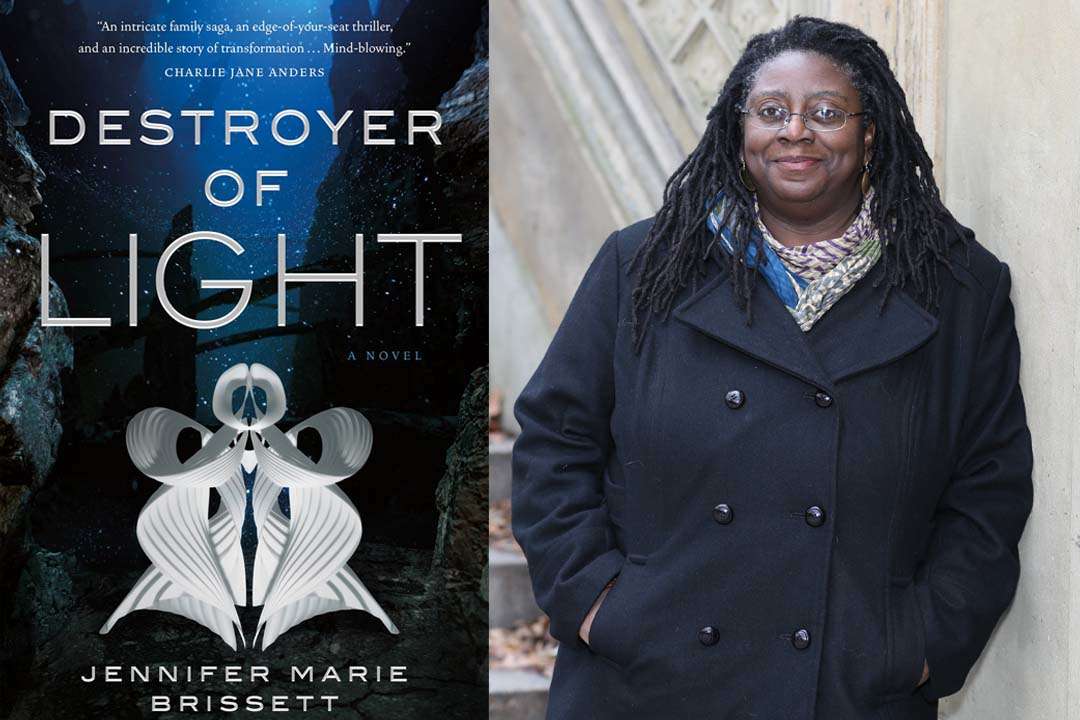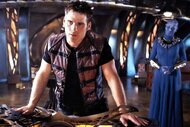Create a free profile to get unlimited access to exclusive videos, sweepstakes, and more!
'Destroyer of Light' author Jennifer Marie Brissett on bringing the Persephone myth to sci-fi
The author's latest novel retells the classic Greek myth in outer space.

Science fiction has a rich tradition of blending the mythological with the speculative, creating whole new worlds and planets based on stories passed down through time with aspects shared across various cultures. Author Jennifer Marie Brissett is the latest author to follow in those footsteps as her novel Destroyer of Light retells the Greek myth of Hades’ abduction of Persephone — but set years in the future on a whole new world, and split across three multiple perspectives.
The story unfolds on the planet Eleusis, where human refugees who had to flee Earth when aliens known as the krestge invaded and destroyed the planet, must now live alongside the aliens responsible for their plight. The krestge followed the remains of humanity with the promise of peace, and while some humans have accepted this truce of sorts, there are others who view them with suspicion. Some of this depends on which sector of Eleusis a person lives as in as half the planet remains stuck in perpetual daytime and the other half in perpetual night. There are habitable sectors in between Day and Night — aptly-named Dawn and Dusk — where humans and krestge co-exist peacefully.
The first of the book’s three storylines follows that of a woman named Deidra as she searches for her daughter Cora, who’s been taken by the rebel army of the warlord Dr. Aidoneus Okoni because of her special gift. Readers familiar with the original myth might recognize them to be versions of Demeter, her daughter Persephone, and Hades himself.Brissett tells SYFY WIRE that she was drawn to the mother-daughter relationship in the myth, but inspiration really struck when she realised that Octavia Butler’s Parable of the Sower was a retelling of the same myth..
“I started to notice some parts of this myth felt eerily familiar and I couldn’t really place where I would know the intricacy of the myth,” Brissett explains. “It was such an inspiration to read this work and to see that underneath it all was this myth. [And that made me think,] ‘Maybe I can do something like this too but in my own way. I have a story to tell.’ It just started to really work and fit.”
Cora’s story continues in another storyline, wherein she is now named Stefonie and (unhappily) married to Okoni. However, when she’s eventually released, she finally has a choice in deciding her own future: either carry out Okoni’s plan, or return to her mother and her former life. But unlike other tellings of the myth which might romanticise the relationship between Persephone and Hades, Brissett wanted to be clear that what happens to Cora, and the other young girls like her in Okoni’s army, is sexual assault.
“Part of the danger of that particular story is that people romanticize what essentially is the story of rape,” explains Brissett, who made sure to include trigger warnings for the book as there are many graphic depictions of sexual assault throughout the novel. “I really wanted to go out of my way to make sure that it was not romantic and that there was little confusion. When Cora gets older and she’s with Okoni she’s a little confused. She thinks she’s in love. But is she? Given a choice would she choose this relationship? I wanted a lot of grey in that sense.”
As part of her research for this part of Cora’s storyline in Destroyer of Light, Brissett did research into the experiences of child soldiers, specifically female ones, and what she discovered only fit in further with her take on this particular myth.“It’s all over the world. Kids are being roped into these really brutal wars and forced to do things. What happens to them afterwards? How do they come out the other side of this?” says Brissett. “That’s what drew me to the story of Persephone. At the end of the poem, everybody’s afraid of her. That’s what happens to these kids, because some people are afraid.”
As brutal as some of the events of Cora’s life can be, Brissett was also careful to make her story that of a survivor, though even that in itself has difficulties. “Being a survivor is a very lonely place, of not being able to really express all the things that have happened to you, because you want to survive in this world. But people are afraid of you as they hear those stories and this is the difficulty of life,” Brissett explains of her approach to Cora’s storyline. “The Persephone story is one that, unfortunately, a lot of women live, of being abused as a young person, and somehow incorporating it into our lives and coming out the other side hopefully stronger and more powerful for it.”
While Destroyer of the Light is not a simple, easy read, some of the more hopeful moments come from the third and final storyline, which follows genetically modified (and psychic) twin detectives, Jown and Pietyr, as they investigate the abduction of a child of human and krestge parents, who are not entirely being upfront. While the characters themselves are from an earlier work of Brissett’s, they still fit into the larger myth, in a way that perfectly encapsulates the author’s approach to it. “As I was working on the book, I said, ‘You know wouldn’t it be interesting if I made the Eleusinian Mysteries an actual mystery?’” says Brissett, referring to the secret rites tied to the myth of Demeter and Persephone, in particular, the separation and eventual reunion of the mother and daughter. “Well, if you have a ‘mystery,’ you need detectives.”
Brissett does not shy away from tough subjects as she weaves together the storylines at the centre of the novel, causing them to overlap and impact each other in various ways. While racism might not exist in the traditional sense — most of the people on the planet have brown skin — there are still systems of inequity in place that people are trying to navigate. Such as people with colored eyes (a sign that they have powers, which makes them feared), trying to cover them up so they can “pass” among the rest of the population. For Brissett, therein lies the power of genre storytelling, be it science fiction or fantasy: the ability to provide readers with something that is both familiar enough that they recognise it, and foreign enough that they know it’s not real.
“Some actually very dark things that happen in The Lord of the Rings! But you are able to absorb them because of this kind of foreign connection. It's away from you, but it's [also] right here,” she says. “The PTSD in Lord of the Rings is real. These guys are really damaged at the end of that story. But you're able to accept it because of these cute little guys and this little comfort zone that he creates. Hobbiton is like a comfort zone.”
Myths and folktales serve a similar purpose, according to Brissett, who views them more as guideposts, or a map for how the world works
“These are old stories that are retold over and over, even in the past when they were never really new,” she says. “But they’re not even Western in and of themselves. Similar things happened in the Mahabharata that also happened in Homer’s stories. There was a cross-connection between the East and West and everybody was sort of telling fragments of the same story in different ways. So we are all connected and these myths are underneath. That’s why we keep updating them. Because the little details may be different, but the underlying stories have a truth that we all sort of recognise. Maybe that’s why we’re drawn to them. ”
Destroyer of Light is available to order now.


























